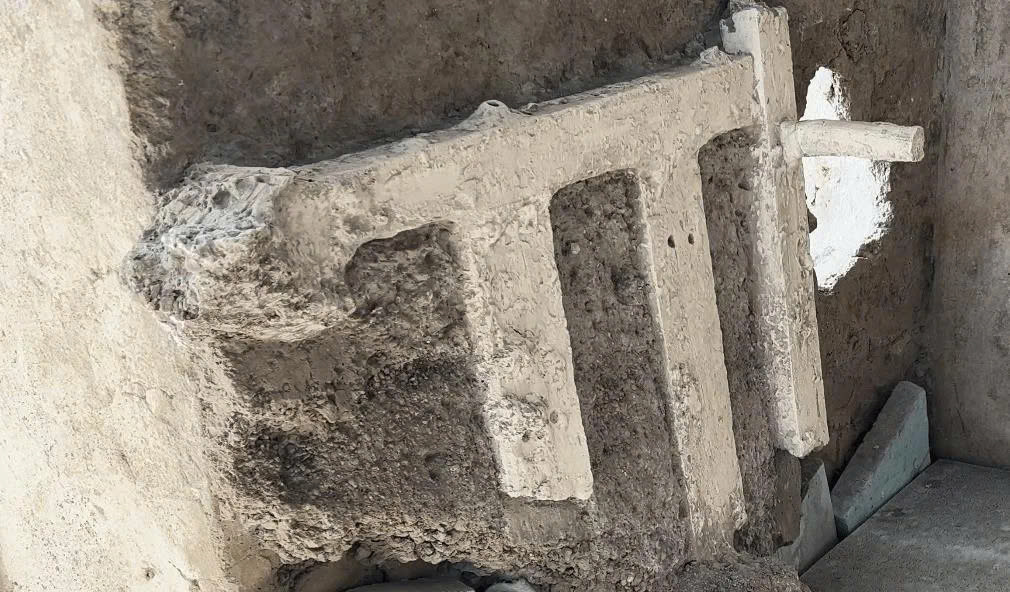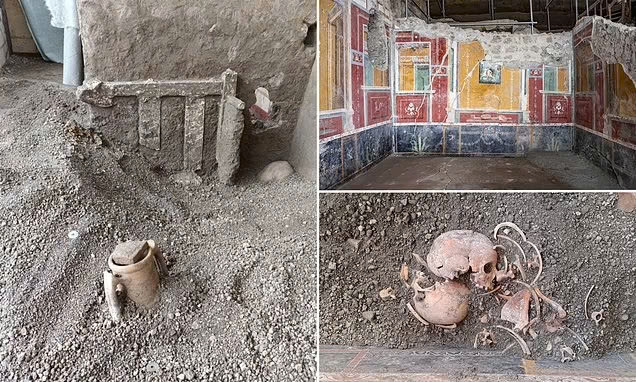Recent archaeological work at Pompeii has uncovered a deeply moving story of a Roman family’s last moments during the catastrophic eruption of Mount Vesuvius in 79 CE. The discovery, made at the House of Helle and Phrixus, provides remarkable insights into daily life and the human experience during one of history’s most significant natural disasters.
The House of Helle and Phrixus: A Window into Roman Life
Architectural Beauty and Cultural Significance

The House of Helle and Phrixus, located on the Via del Vesuvio, represents a typical middle-class Roman residence. This well-appointed home featured elegantly decorated rooms, including a central atrium with a rainwater collection basin, a formal dining area, and private sleeping quarters. The house takes its name from a beautiful fresco in the dining room that depicts the mythological tale of Phrixus and his sister Helle.
The artwork shows the legendary scene of Helle’s unfortunate fall into the sea while escaping on a magical winged ram. Such sophisticated mythological references were common among Pompeii’s educated residents, serving to demonstrate their cultural knowledge and social standing within the community.
Evidence of Daily Life and Ongoing Changes
Archaeological findings reveal that the family was in the midst of home improvements when disaster struck. Missing doorway thresholds, unfinished decorative work, and construction marks throughout the house indicate active renovation projects. Despite the disruption, the family had chosen to remain in their home during these improvements.
The excavation also uncovered fascinating glimpses into Roman domestic life. Researchers found storage jars that once contained garum, a popular fermented fish condiment of the era. A remarkable collection of bronze kitchenware was discovered neatly organized beneath a staircase that served as a pantry, including serving ladles, pouring vessels, decorative containers, and an ornate shell-shaped drinking cup.

The Family’s Final Hours
Seeking Safety as Danger Approached
As volcanic debris began falling through an opening in the roof above the central courtyard, the family retreated to a bedroom for protection. In their efforts to create a safe haven, they moved a wooden bed to barricade the door entrance. This makeshift barrier, though ultimately insufficient, demonstrates their determination to survive the unfolding catastrophe.
Video
Archaeological Evidence of Lives Lost

Within this room, researchers discovered the remains of at least four individuals, including a young child. Near the child’s remains lay a bronze bulla, a protective amulet traditionally worn by Roman boys until they reached adulthood. This small artifact serves as a poignant reminder of the young lives affected by this natural disaster.
The preservation techniques used by archaeologists, including plaster casting to reveal the shapes of decomposed organic materials, have allowed researchers to reconstruct the scene and understand the family’s final actions.
Scientific Understanding and Historical Significance
The Final Moments
According to Dr. Gabriel Zuchtriegel, Director of the Archaeological Park of Pompeii, these discoveries highlight both the artistic achievements of Roman civilization and the vulnerability of human life. The excavation reveals how residents attempted to protect themselves by creating barriers, though ultimately the overwhelming force of nature proved insurmountable.

The final phase of the eruption brought an intense surge of heated ash and debris, with temperatures reaching between 180 and 360 degrees Celsius. This powerful natural force preserved the scene exactly as it occurred nearly two thousand years ago.
Preservation and Public Access
Thanks to ongoing conservation efforts, the House of Helle and Phrixus, along with nearby archaeological sites such as the House of Leda and the Swan, will soon be accessible to visitors. These carefully preserved locations offer unique opportunities for the public to connect with ancient history and understand the daily lives of Pompeii’s residents.
Continuing Archaeological Discoveries

The findings from the House of Helle and Phrixus, documented in the E-Journal of the Pompeii Excavations, represent just one example of the ongoing archaeological work that continues to reveal new aspects of life in ancient Pompeii. Each discovery adds to our understanding of Roman society, family life, and the human experience during this pivotal moment in history.
These archaeological investigations demonstrate how modern scientific techniques can bring ancient stories to life, allowing us to connect across centuries with the experiences of those who came before us. The careful documentation and preservation of these sites ensures that future generations will continue to learn from these remarkable historical records preserved in volcanic ash.

